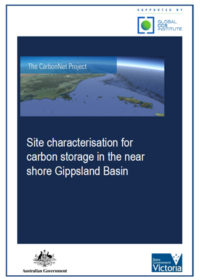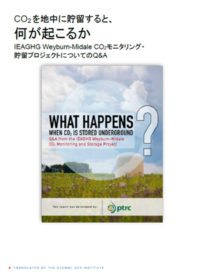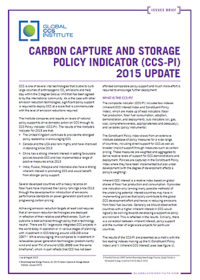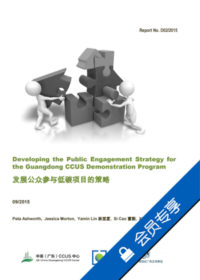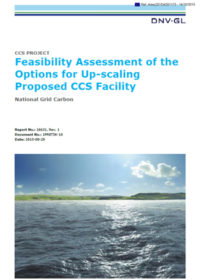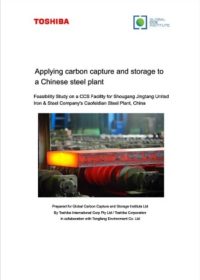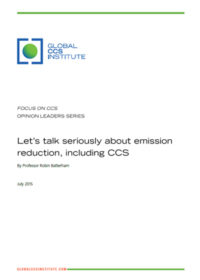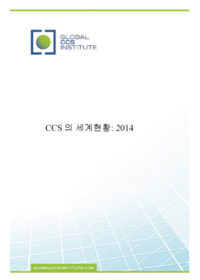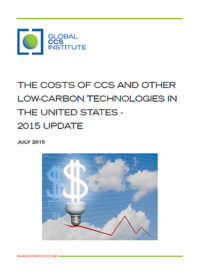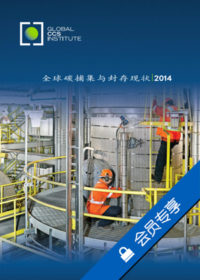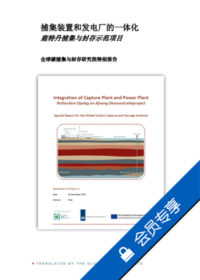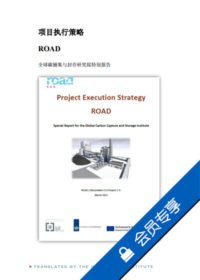Resources
Publications
Our publications, reports and research library hosts over 500 specialist reports and research papers on all topics associated with CCS.
View our Publication Library Disclaimer.
Filter by
The CarbonNet Project: site characterisation for carbon storage in the near shore Gippsland Basin
7th September 2015
Topic(s): Carbon capture use and storage (CCUS), CO2 storage
The Global CCS Institute presents a carbon dioxide (CO2) storage site characterisation study for the CarbonNet Project. The CarbonNet project is investigating the potential to establish a CCS Hub bringing together multiple CO2 capture projects in Victoria’s Latrobe Valley, transporting CO2 via a shared pipeline and injecting it into the offshore Gippsland Basin. The report details the steps taken during the screening of potential storage sites in the offshore Gippsland Basin.
Three of the highest ranked sites are identified and their geological characteristics detailed and suitability for CO2 storage are described. The report found that all three storage sites are located nearshore and have the potential to dispose of between 25 and 15 Mt of CO2 permanently in deep saline formations.
This report is authored by Nick Hoffman, George Carman, Mohammad Bagheri, Todd Goebel; and the CarbonNet Project for the Global CCS Institute. Chris Consoli, Institute Senior Adviser for Storage, Asia-Pacific also provides an overview of the report in a new Insight available on the Global CCS Institute website.
Disclaimer
The content within the Global CCS Institute Publications, Reports and Research Library is provided for information purposes only. We make every effort and take reasonable care to keep the content of this section up-to-date and error-free. However, we make no claim as to its accuracy, currency or reliability.
Content and material featured within this section of our website includes reports and research published by third parties. The content and material may include opinions and recommendations of third parties that do not reflect those held by the Global CCS Institute.
CO2を地中に貯留すると、何が起こるか – IEAGHG Weyburn-Midale CO2モニタリング・貯留プロジェクトについてのQ&A
4th September 2015
Topic(s): Carbon capture use and storage (CCUS), CO2 storage, Health safety and environment
IEAGHG Weyburn-Midale CO2モニタリング・貯留プロジェクトは、カナダ・サスカチェワン州南東の石油埋蔵地貯留所へのCO2圧入および貯留効果を調査するために設計された研究プログラムである。「CO2を地中に貯留すると、何が起こるか」は、CCSについて一般市民から頻繁に寄せられる質問に対し、上記プロジェクトから得られた広範囲に及ぶデータおよび調査結果に基づく回答をまとめたものである。
Japanese translation of What happens when CO2 is stored underground? Q&A from the IEAGHG Weyburn-Midale CO2 Monitoring and Storage Project.
Disclaimer
The content within the Global CCS Institute Publications, Reports and Research Library is provided for information purposes only. We make every effort and take reasonable care to keep the content of this section up-to-date and error-free. However, we make no claim as to its accuracy, currency or reliability.
Content and material featured within this section of our website includes reports and research published by third parties. The content and material may include opinions and recommendations of third parties that do not reflect those held by the Global CCS Institute.
Carbon Capture and Storage Policy Indicator (CCS-PI): 2015 update
2nd September 2015
Topic(s): Carbon capture use and storage (CCUS), Carbon markets, Domestic policy, Economics, Policy law and regulation
The Institute has developed an analytical framework to derive a composite indicator that compares levels of national policy support to drive domestic action on CCS.
This 2015 update of the CCS Policy Indicator includes some important developments that have occurred in several major countries since it was last published in 2013.
Disclaimer
The content within the Global CCS Institute Publications, Reports and Research Library is provided for information purposes only. We make every effort and take reasonable care to keep the content of this section up-to-date and error-free. However, we make no claim as to its accuracy, currency or reliability.
Content and material featured within this section of our website includes reports and research published by third parties. The content and material may include opinions and recommendations of third parties that do not reflect those held by the Global CCS Institute.
全球碳捕集与封存研究院和中英(广东)CCUS中心授权该报告介绍了由华润电力(海丰)和中国海洋石油总公司(中海油)一体化碳捕集与封存示范项目(CRP Power Project)实施的项目公众参与战略开发的过程。
此次行动在中国属于首例且是一个持续的过程。到目前为止,CCS公众参与项目案例研究的主要工作是,分析了欧洲、北美和澳大利亚既有的活动。下一步的重点就是仔细考虑目前的最佳实践如何在其他区域环境中得到应用。从CRP Power Project中所学到的经验教训可能对于中国其他考虑公众参与战略发展的CCS项目支持者们很有用。
该报告经由Peta Ashworth(Ash Research)、Jessica Morton(全球碳捕集与封存研究院)、林亚茗和曹斯(南方新闻)和梁希(中英(广东)CCUS中心)授权。授权者们希望感谢林千果(全球碳捕集与封存研究院)和David Reiner博士(剑桥大学贾吉商学院)对本报告的战略性建议和投入。
Jessica Morton,研究院亚太区公众参与高级顾问写了一份观点,对本报告进行了综述并介绍了亚太区近期其他的CCS公众参与活动。
Disclaimer
The content within the Global CCS Institute Publications, Reports and Research Library is provided for information purposes only. We make every effort and take reasonable care to keep the content of this section up-to-date and error-free. However, we make no claim as to its accuracy, currency or reliability.
Content and material featured within this section of our website includes reports and research published by third parties. The content and material may include opinions and recommendations of third parties that do not reflect those held by the Global CCS Institute.
Feasibility assessment of the options for up-scaling proposed CCS facility
28th August 2015
Topic(s): Carbon capture use and storage (CCUS), CO2 transport
National Grid Carbon (NGC) is developing a carbon dioxide transportation and storage system to support the provision of Carbon Capture and Storage technology in the Yorkshire and Humber region.
Initially, this will involve the construction of a cross country pipeline and subsea pipeline for transporting captured CO2 to a permanent storage site in the Bunter sandstone aquifer located within Block 5/42 of the UK sector of the Southern North Sea.
The initial CO2 load is anticipated to be supplied by the Drax power station and will be a maximum of 2.68 Million Tonnes per Annum (MTPA). However, with this load, the utilisation of the proposed CCS facility will be well below its capacity. NGC anticipates a second CO2 load from the Don Valley Power project to enhance the aquifer utilisation. In addition, NGC is also seeking to review potential options for up-scaling the CCS facility by transporting additional CO2 from Rotterdam via ship or pipeline into the proposed injection facility.
DNV GL have been engaged by NGC to carry out a feasibility study to assess two options for up-scaling the proposed carbon capture and storage facilities. Option 1 proposes to transport CO2 from Rotterdam directly to the injection facility in the Southern North Sea (Pipeline Option) whilst Option 2 proposes to transport CO2 by ship from Rotterdam to a reception facility on the River Humber, from where a pipeline will connect into the proposed CCS Cross Country pipeline at Camblesforth multi-junction (Shipping Option).
Three flow rates have been assessed for each option; (A) 2 MTPA, (B) 5 MTPA, and (C) 7.32 MTPA.
The findings and recommendations from this study are presented in this report.
Disclaimer
The content within the Global CCS Institute Publications, Reports and Research Library is provided for information purposes only. We make every effort and take reasonable care to keep the content of this section up-to-date and error-free. However, we make no claim as to its accuracy, currency or reliability.
Content and material featured within this section of our website includes reports and research published by third parties. The content and material may include opinions and recommendations of third parties that do not reflect those held by the Global CCS Institute.
Applying carbon capture and storage to a Chinese steel plant
27th August 2015
Topic(s): Carbon capture use and storage (CCUS), CO2 capture, Engineering and project delivery
The Global CCS Institute presents a feasibility study report on applying carbon capture and storage (CCS) to a steel plant in China. Toshiba was commissioned to conduct the study through its business partner Tongfang Environment in collaboration with Shougang Jingtang United Iron & Steel of China. The study examined the application of CCS onto the Caofeidian steel plant.
The report covers the concept of capturing CO2 from a Chinese steel plant, transportation and potential storage in an oilfield for enhanced oil recovery (EOR).
The study suggests that carbon capture in Chinese steel plants is a cost effective means of reducing carbon emissions compared with similar plants around the world.
This report is authored by Toshiba for the Global CCS Institute. Tony Zhang, Institute Senior Adviser for Carbon Capture, Asia-Pacific also provides an overview of the report in a new Insight available on the Global CCS Institute website.
Disclaimer
The content within the Global CCS Institute Publications, Reports and Research Library is provided for information purposes only. We make every effort and take reasonable care to keep the content of this section up-to-date and error-free. However, we make no claim as to its accuracy, currency or reliability.
Content and material featured within this section of our website includes reports and research published by third parties. The content and material may include opinions and recommendations of third parties that do not reflect those held by the Global CCS Institute.
Let's talk seriously about emission reduction, including CCS
3rd August 2015
Topic(s): Carbon capture use and storage (CCUS)
Professor Robin Batterham’s article, Let’s talk seriously about emission reduction, including CCS, is part of an opinion leader’s article series for Focus on CCS. The series features contributions from world leading authorities on carbon capture and storage (CCS), presenting their perspectives on the role for the technology in reducing our carbon dioxide emissions. The series is published by the Global CCS Institute to contribute to the conversation about CCS within the portfolio of options to help tackle climate change.
Professor Batterham is Kernot Professor of Engineering at the University of Melbourne. Until recently, he was Group Chief Scientist, Rio Tinto Limited, President of the Australian Academy of Technological Sciences and Engineering, and Chairman of the International Energy Agency Expert Group on Science for Energy.
Disclaimer
The content within the Global CCS Institute Publications, Reports and Research Library is provided for information purposes only. We make every effort and take reasonable care to keep the content of this section up-to-date and error-free. However, we make no claim as to its accuracy, currency or reliability.
Content and material featured within this section of our website includes reports and research published by third parties. The content and material may include opinions and recommendations of third parties that do not reflect those held by the Global CCS Institute.
2014-15 – CCS의 구심점이 되는 시기
2014년 10월, 캐나다 서스캐처원(Saskatchewan)에 위치한 바운더리 댐(Boundary Dam) 발전소에서는 전력 분야 세계 최초의 대규모 탄소 포집 저장 (CCS) 프로젝트가 시작되었다. 전력 분야에서 두 개의 추가적인 대규모 CCS 프로젝트는 미시시피에 위치한 켐퍼 카운티 에너지 시설(Kemper County Energy Facility)과 텍사스에 위치한 페트라 노바 탄소 포집 프로젝트(Petra Nova Carbon Capture Project)로 각각 2015년과 2016년 가동에 들어갈 것으로 계획 중이다. 철강 분야에서도 세계 최초 대규모 CCS 프로젝트인 아부다비 CCS 프로젝트가 현재 아랍에미리트(UAE)에서 건설 중이다. 이 4개의 프로젝트는 전 세계에서 운전 중이거나 건설 중인 22개의 대규모 CCS 프로젝트 중 하나이며, 이러한 프로젝트 숫자는 2010년대 초에 비해 두 배로 증가한 수치이다.
대규모 CCS 전력 프로젝트가 실현됨에 따라, CCS 기술의 상용화에 있어서 중요한 이정표가 세워졌다. 이는 이제 기후 변화 완화를 위한 저비용 접근 방식의 일환으로 CCS를 가장 잘 상용화할 수 있는 방법에 대한 논의를 시작할 때가 되었음을 의미한다. 우리는 이제 CCS의 ‘실험적’ 특성에 대한 논쟁 또는 CCS가 화석연료 발전소에 대대적으로 적용되지 않고 있다는 논쟁으로부터 벗어날 수 있다.
Korean translation of The Global Status of CCS: 2014 .
Disclaimer
The content within the Global CCS Institute Publications, Reports and Research Library is provided for information purposes only. We make every effort and take reasonable care to keep the content of this section up-to-date and error-free. However, we make no claim as to its accuracy, currency or reliability.
Content and material featured within this section of our website includes reports and research published by third parties. The content and material may include opinions and recommendations of third parties that do not reflect those held by the Global CCS Institute.
The costs of CCS and other low-carbon technologies in the United States: 2015 update
27th July 2015
Topic(s): Carbon capture use and storage (CCUS), Economics
This paper examines costs of major low and zero emissions technologies currently available in power generation and compares them in terms of emissions reduction potential and costs. The analysis uses cost and performance data from several recent studies in the United States, and applies a common methodology and economic parameters to derive comparable lifetime costs per generation output and of CO2 avoided.
The analysis demonstrates that CCS is a cost competitive power sector emissions reduction tool when considered among the range of available low and zero emissions technologies. While CCS adds additional costs to traditional fossil fuel generation, the underlying coal and gas generation technology and fuel sources are relatively cheap, and CCS has higher rates of utilisation than some renewables technologies.
This publication updates the 2011 edition of The costs of CCS and other low-carbon technologies.
Disclaimer
The content within the Global CCS Institute Publications, Reports and Research Library is provided for information purposes only. We make every effort and take reasonable care to keep the content of this section up-to-date and error-free. However, we make no claim as to its accuracy, currency or reliability.
Content and material featured within this section of our website includes reports and research published by third parties. The content and material may include opinions and recommendations of third parties that do not reflect those held by the Global CCS Institute.
全球碳捕集与封存研究院很高兴宣布2014年全球碳捕集与封存现状报告的发布。
本报告详述了世界范围内大型CCS项目的现状,认为:2014年对CCS来说是关键的一年,在这一年里CCS在电力行业成为了现实。
本报告介绍并提供了大约40个较小规模的“值得注意的”CCS项目的项目描述链接。2014年报告强调了日本“值得注意的”项目的数量。
2014年全球碳捕集与封存现状报告对全球和区域性的CCS发展以及支持缓解全球气候变化需要什么等进行了全面概述。为决策者们提供了一些主要的建议:2014年全球碳捕集与封存现状报告对企业、政府、研究实体和更广泛的社区都是一个重要的参考指南。
Disclaimer
The content within the Global CCS Institute Publications, Reports and Research Library is provided for information purposes only. We make every effort and take reasonable care to keep the content of this section up-to-date and error-free. However, we make no claim as to its accuracy, currency or reliability.
Content and material featured within this section of our website includes reports and research published by third parties. The content and material may include opinions and recommendations of third parties that do not reflect those held by the Global CCS Institute.
捕集装置和发电厂的一体化。鹿特丹捕集与封存示范项目。全球碳捕集与封存研究院特别报告
2nd July 2015
Topic(s): Carbon capture use and storage (CCUS), Engineering and project delivery
本报告关注马斯莱克迪电厂现有的燃煤1070兆瓦第三机组和ROAD项目拟建的新的250兆瓦规模的碳捕集厂的整合。碳捕集技术已经成为大量的降低碳捕集与封存成本研究的课题,也是很多刊物的主题。然而,与主要电厂的整合对于CCS链的效率和可操作性也有着重要的影响,是一项独立的非常大的项目成本。
Disclaimer
The content within the Global CCS Institute Publications, Reports and Research Library is provided for information purposes only. We make every effort and take reasonable care to keep the content of this section up-to-date and error-free. However, we make no claim as to its accuracy, currency or reliability.
Content and material featured within this section of our website includes reports and research published by third parties. The content and material may include opinions and recommendations of third parties that do not reflect those held by the Global CCS Institute.
项目执行策略。ROAD。全球碳捕集与封存研究院特别报告
2nd July 2015
Topic(s): Carbon capture use and storage (CCUS), Engineering and project delivery
随着总公司作出投资决策项目迈出了里程碑式的一步,本报告旨在对该项目的未来之路提出一个纲要。本报告还综述了即将到来的里程碑、相关活动的讨论以及项目执行战略。最终投资决策(FID)之后,将要组成两个连续组织,第一个关注于2015年之前的设计和建设,同时第二个将关注于2015年到2020年间项目的运行。该项目雇佣了来自两个总公司的技术专家,与战略伙伴一起在项目的开发和运行阶段发挥作用。
该项目进度由MPP3建设进度和成本优化所驱动。为了避免MPP3停机处罚,协调工作必须要走上正轨。ROAD关注于成本优化和控制。两个驱动因素都导致了具体建设计划和大型起重机组件的聚集。大型船只和主要压缩机的起重活动起着关键作用。由于大型起重机组件的聚集,成本和项目进度可以大幅压缩。这些主要组件的起重和布置之后,捕集厂就可以装配了。在第二个阶段,运输和封存工作将会是关注的重点。从前端设计阶段开始,更为详尽的设计让ROAD减少了不确定性。本报告讨论了施工、融资、调度、利益相关者参与和许可等执行阶段的风险。缓和风险的措施日渐地降低了项目意外开支。项目意外开支因不稳定的市场价格、工程细节状态、规划的不确定性和其他事件而显现出来。前端工程设计研究使得意外成本支出从总资本支出的25%(FEED前)减少到10%(FEED后)。施工阶段剩下的主要风险是与MPP3的联络、及时签署的捕集厂建设EPC合同、和意外支出风险与运输和封存链的商业磋商。此外,许可和利益相关者管理是注意的焦点。NGO或者地方组织对发放许可的反对或者上诉可能导致调度问题。
项目预算是由公司的组织结构控制,预算在项目办公司和管理、利益相关者管理、捕集、最后还有运输和封存中间分配。预算在整个项目周期中被分割成两个阶段:设计和施工阶段(2010-2014)和运行阶段(2015-2019)。进入运行阶段之后,已经制定出了厂退役和封存点监测的相关规定。考虑到风险的可能性和确定的减排措施,在ROAD的概率模型中,FID延期的调度风险也可能显现出来。请注意,本报告仅仅强调ROAD项目执行策略的主要方面。
Disclaimer
The content within the Global CCS Institute Publications, Reports and Research Library is provided for information purposes only. We make every effort and take reasonable care to keep the content of this section up-to-date and error-free. However, we make no claim as to its accuracy, currency or reliability.
Content and material featured within this section of our website includes reports and research published by third parties. The content and material may include opinions and recommendations of third parties that do not reflect those held by the Global CCS Institute.
